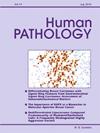Epithelioid trophoblastic tumor in male patients with germ cell tumor: A clinicopathologic analysis of five cases
IF 2.7
2区 医学
Q2 PATHOLOGY
引用次数: 0
Abstract
Epithelioid trophoblastic tumor (ETT) is an extremely rare chorionic-type neoplasm in the testis, with only seven cases reported in the literature. Here, we report five cases of testicular ETT from a single institution, constituting the largest series of this rare tumor to date. The patients had a mean age of 44 years (range, 20–68 years). Four patients had a previous history of testicular germ cell tumor (GCT) treated with chemotherapy, and they developed ETT in metastatic sites in a mean of 11 years (range, 3–15 years) after the initial diagnosis of testicular GCT. Only one patient had ETT in the testis. Three patients had a normal serum beta–human chorionic gonadotropin (β-hCG) level, and two patients had a level that was slightly elevated, but far below that typically seen in patients with choriocarcinoma. ETT was characterized by a proliferation of intermediate trophoblastic cells with abundant eosinophilic cytoplasm, and the tumors frequently had coagulative necrosis with eosinophilic debris, mimicking keratinizing squamous cell carcinoma. The trophoblastic phenotype of ETT was supported by its immunoreactivity for trophoblastic markers, including GATA-3 (3 of 3 cases tested), α-inhibin (3/4), p63 (3/5), and β-hCG (3/4). ETT was also positive for cytokeratin (4/4) and GCT marker SALL4 (3/3). Despite surgery and chemotherapy, two patients died of disease 17 months after ETT diagnosis, and three patients were alive with metastatic disease at a mean of 20 months (range, 15–28 months). Our results demonstrate that ETT may be an aggressive disease associated with distinct pathologic features and poor clinical outcome.
男性生殖细胞瘤患者的上皮样滋养细胞肿瘤:五例病例的临床病理学分析。
上皮样滋养细胞瘤(ETT)是一种极其罕见的睾丸绒毛膜状肿瘤,文献中仅报道了七例。在此,我们报告了来自一家医疗机构的五例睾丸上皮滋养细胞瘤病例,这是迄今为止关于这种罕见肿瘤的最大系列病例。患者的平均年龄为 44 岁(20-68 岁)。四名患者曾患化疗治疗过的睾丸生殖细胞瘤(GCT),他们在初次确诊睾丸GCT后平均11年(3-15年)在转移部位出现ETT。只有一名患者的ETT发生在睾丸。三名患者的血清β-人绒毛膜促性腺激素(β-hCG)水平正常,两名患者的血清β-人绒毛膜促性腺激素(β-hCG)水平略有升高,但远低于绒毛膜癌患者的正常水平。ETT的特点是中间滋养层细胞增生,胞浆中有大量嗜酸性细胞,肿瘤经常出现凝固性坏死,并伴有嗜酸性碎屑,模仿角化性鳞状细胞癌。ETT的滋养细胞表型得到了滋养细胞标志物免疫反应的支持,这些标志物包括GATA-3(检测的3例中有3例)、α-抑制素(3/4)、p63(3/5)和β-hCG(3/4)。ETT的细胞角蛋白(4/4)和GCT标记物SALL4(3/3)也呈阳性。尽管进行了手术和化疗,但仍有两名患者在确诊 ETT 17 个月后死于疾病,三名患者在平均 20 个月(15-28 个月)后因转移性疾病存活。我们的研究结果表明,ETT可能是一种侵袭性疾病,具有明显的病理特征,临床预后较差。
本文章由计算机程序翻译,如有差异,请以英文原文为准。
求助全文
约1分钟内获得全文
求助全文
来源期刊

Human pathology
医学-病理学
CiteScore
5.30
自引率
6.10%
发文量
206
审稿时长
21 days
期刊介绍:
Human Pathology is designed to bring information of clinicopathologic significance to human disease to the laboratory and clinical physician. It presents information drawn from morphologic and clinical laboratory studies with direct relevance to the understanding of human diseases. Papers published concern morphologic and clinicopathologic observations, reviews of diseases, analyses of problems in pathology, significant collections of case material and advances in concepts or techniques of value in the analysis and diagnosis of disease. Theoretical and experimental pathology and molecular biology pertinent to human disease are included. This critical journal is well illustrated with exceptional reproductions of photomicrographs and microscopic anatomy.
 求助内容:
求助内容: 应助结果提醒方式:
应助结果提醒方式:


